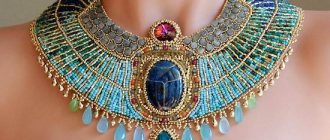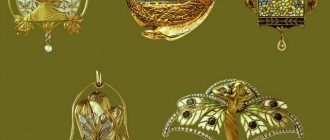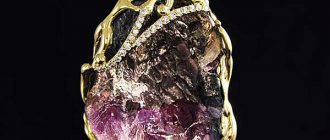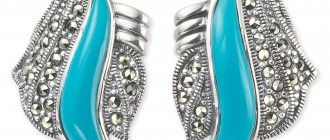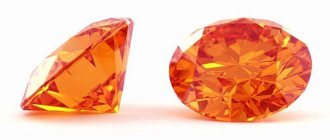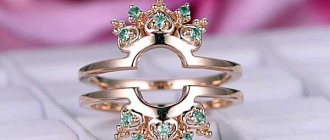Jewelry in ancient Egyptian style
They date back to ancient times. It also includes Greek and Byzantine styles. Egyptian is the most mystified. Most of the decorations contain divine images.
These are not only creatures with the bodies of people and the heads of dogs and birds, but also their earthly incarnations. The scarab, for example, is one of the forms of the god Ra. The beetle is also present in many modern Egyptian-style jewelry.
Symbolically, jewelry means a connection with the luminary, feeding it with energy. Therefore, the use of gold or alloys of yellow tones is typical for the Egyptian direction.
Silver was used less, but it was valued on a par with gold, since it was associated with Isis. This is the goddess of fertility, and at the same time the secrets of life. So, jewelry made of Egyptian style from silver appeals to the feminine, maternal, creative principles.
Since jewelry in Egypt was dedicated to deities, thus appealing to their favor, the jewelry was made massive and bright. Must be visible from heaven. By the way, the Egyptians considered each stone in jewelry to be a conductor to the energy of one of the stars.
The favorite gems of the ancient people were lapis lazuli, carnelian, rock crystal, and garnets. They are also used to decorate modern bracelets and necklaces in order to preserve the style of the Egyptian era.
Egyptian style decoration
Empire: Empire style in jewelry
Empire style (from the French empire) is the final phase in the evolution of the classicism style in the decorative and applied arts of the 19th century. The main sources of creative rethinking and inspiration are the archaic art of Ancient Greece, the art of imperial Rome and Ancient Egypt. In antiquity, the Empire style drew, on the one hand, monumentality and laconicism, and on the other, the idea of affirming imperial greatness through appropriate attributes and symbols. The new European order introduced by Napoleon served as the basis for the constitution of the following constitutional monarchies. Many saw him as a “new man”; he was compared to Emperor Augustus.
Having become Emperor of France in May 1804, Napoleon realized his ambitions in the field of art. He ideologized it, deliberately connecting his interests with the art of ancient empires - it, too, was to form the basis of his new empire. Although the Empire style did not last long, it became an excellent culmination of the classical traditions of the 18th century and at the same time stood out as an independent period of art due to its great social pathos and forms. The entire history of the development of art in the 19th century is divided into three parts: at the beginning of the century - the Empire style, then - the period of aesthetic wanderings and eclectic searches (historicism style) and, finally, the Art Nouveau style.
The Empire style personified the power of the empire, which is why it manifested itself so easily and fully in France and Russia, creating in its time the image of a “great” sovereign and nation through majestic and warlike images and allegories.
By the beginning of the next century, high jewelry art in the last quarter of the 18th century in Russia was represented by a strict, rational, regulated style of classicism, based on ancient examples, which was preferred by Empress Catherine the Great. In 1782, she issued a decree to simplify the court toilet. Of course, this decree also influenced the style of jewelry. In Russia, the art of classicism (considered “neoclassicism” in Europe during this historical period) acquired a sense of citizenship, which was expressed in a fascination with ancient images and forms, architectural orders, mythological and ornamental motifs. Ancient imagery was identified with the concept of good taste. At the same time, having easily entered Russian art as a style, the Empire style acquired recognizable features of Russian stylistics - reliance on artistic ideas, images and forms of the past naturally implied stylization as a method of Russian masters.
The main sources of the Empire style are the heritage of archaic Greece, Ancient Egypt and Rome during the empire. It is in them that the idea of asserting imperial greatness with monumentality and laconicism of form is so well combined. The Empire style is characterized by a special militant semiotics, attributes and symbols (triumphal arches, columns, obelisks - reliefs with a military theme and emblems are often found in architectural details and decor; furniture, vases, clocks, ornaments are associated with special emblems - armor, laurel wreaths, lictors ligaments, eagles, etc.); combinations of dark wood and applied gilded bronze decor in the spirit of Egyptian and Roman ancient jewelry give a special effect.
After their coronation in December 1804, Napoleon and Josephine had at their disposal jewelry preserved from previous French kings, most of which they gave to be remade in the neoclassical style, thus indicating their connection with the empires of Greece and Rome and emphasizing their imperial status. The crown for Napoleon was made by the jewelry house Nitot et Fils; it was a very unusual combination of ancient cameos and intaglios inserted into a thin gold frame. Josephine Beauharnais very soon became a great trendsetter and the main patron of jewelry houses - jewelry was her greatest weakness, and she spent all the money that was allocated for her annual maintenance on them. When she divorced Napoleon, she was forced to return all the jewelry that belonged to the crown, but she left many gifts and purchases, including a tiara made for her coronation, in which 1040 diamonds were inserted. By the time of her death in 1814, her collection was valued at approximately two million French francs. In 1810, Napoleon divorced Josephine and married Marie-Louise. His new wife also began to receive new sets of jewelry that had already been ordered for her, including diamonds, cut diamonds, pearls, emeralds, rubies, sapphires, and opals. On the occasion of the birth of his son, the King of Rome, in 1811, he gave her a diamond necklace, which is now kept in the collection of the Smithsonian Institution in Washington.
The costumes and dresses of that time served as an excellent backdrop for the colored stones. Jewelry designs from this period do not look excessive. They are discreetly cool, with garlands of laurel leaves and ribbons with ancient Greek patterns arranged with geometric precision and balance. Artistic ideas were borrowed from ancient architectural details. Jewelry sets typically consisted of a necklace, a pair of bracelets, dangling earrings, a belt buckle, and four types of hair ornaments: a comb, a tiara, a tiara, and a bandeau. Jewelry could only be made of diamonds, but large colored gemstones were often framed with small diamonds. At that time, Brazil remained the main supplier of diamonds, and Amsterdam was the main cutting center. Diamond-cut stones were more popular, while rose-cut stones were less popular. They were set in silver, often on a gold base, and colored stones were set in gold.
Empire style effects, graphics, lines and artistic forms are easily read in jewelry. This is the diadem of Empress Elizaveta Alekseevna (nee German Princess Louise-Maria-Augusta of Baden-Baden) - the wife of the Russian Emperor Alexander I. Special stones, and even more valuable ones, often outlive their owners. Like, for example, a large flat soft pink diamond of 13 carats that belonged to Paul I. It is located in the center of a tiara of 175 diamonds, 1200 pure roses and silver. The skillful selection of precious stones creates a wave-like shine of sparkling old Indian cut diamonds, which is repeated in a number of moving pandeloks, giving clarity to the form and stylistic grace of the whole thing. The overlap between Empire fashion and the fashion of Ancient Greece gave this decoration a special coloring. Ancient Greek tiaras later became symbols of royal power; gradually transforming, they turned into hoops and crowns.
At the end of the 18th century, it was fashionable to decorate tiaras with colored precious stones in such a way that a name or some word could be read from the first letters of their names. The diversity of the products reduced their artistic expressiveness. The impeccability of shapes, lines, the rigor of the silhouette graphics, the ornament made only of diamonds and possessing the purity and clarity of the design - all this is characteristic of works of the Empire style. The diadem is kept in the Diamond Fund, as is the Small Imperial Crown, which was placed on the head of Elizabeth Alekseevna during the coronation.
It was completed by the Duval brothers in 1801. These jewelers had previously remade the Great Crown created by Jeremiah Pozier for Catherine the Great. Paul I, who did not like his mother, asked them to change the crown. It and the specially made Small Imperial Crown were first created on the occasion of the first joint coronation in history - Paul I and
his wife Maria Fedorovna. The total weight of the Small Crown is 378 grams. It’s amazing how the Duval craftsmen managed to give a coronation item intended for a special occasion the lightness and grace of a woman’s jewelry, as if woven from diamond lace. This early 19th century crown of 48 large (from 2 to 9 carats) and 200 small diamonds of pure water and silver corresponded to the artistic principles of the emerging Empire style. Like the jewelry crowning Josephine (given to her by Napoleon’s sister, Queen of Naples Caroline Murat): a tiara, brooch, earrings and comb made of gold in combination with carved cameos, and a “simple” female comb (the work of a Russian master) made of horn and gold , enamel and cameo - things are made in accordance with all the stylistic laws of the empire style.
The beginning of the century is marked by the widespread popularity of carved cameos. The fine plasticity in stone fascinated both the French and Russians. Napoleon chose cameos to adorn his crown at his coronation in 1804. His interest in cameos was so great that the following year he founded the French school of stone carving. For him, these stones represented a connection with the ancient empires of Greece and Rome. Other members of his family also enjoyed wearing cameo jewelry combined with diamonds or simply gold and enamel. Josephine had a tiara carved from a large shell, covered with mythological scenes, which was then set in gold. Marie-Louise received a set that included twenty-four ancient cameos borrowed from the collection of French kings. In 1805, the Journal des Dames wrote on this occasion that cameos, ancient or modern, carved from shells, had never been so fashionable: now “fashionable women wore cameos on their belts, cameos in necklaces, cameos in each bracelet, a cameo in the tiara.” This fashion was supported by Josephine herself, who had a large selection of not only ancient crafts, but also modern cameos sent to her from Italy by Napoleon's sister Caroline Murat, whose husband became king of Naples in 1808.
The best jewelers in Russia created cameos, cameos were brought from abroad. For some time they even eclipsed diamonds and gems. Cameos were used to create bracelets and sets of jewelry; cameos were used for brooches, buckles, necklaces, rings, and pendants. A thin silver or gold frame played only a secondary role, holding the stone in the right place.
The cameos paired beautifully with diamonds and pearls. Among the highest Russian nobility, cameos became extremely popular because they were symbols of their beloved antiquity that could be carried with them. The agate cameo - the head of Pallas Athena with an olive branch on the helmet and the head of the Gorgon Medusa on the shield - is decorated with an ornament of diamonds and diamonds in gold and silver. Presumably, this brooch was a gift to Princess Maria Pavlovna (the third daughter of Emperor Paul I), presented on the day of her marriage to Crown Prince Karl August Friedrich of Saxe-Weimar-Eisenach in 1804. The cameo personified the extraordinary qualities of the new owner, worthy of the granddaughter of Catherine the Great, for whom Minerva (Athena) was an important person. We know many portraits of Catherine in the image of this goddess. And Maria Pavlovna was considered “one of the best and outstanding women of her time.” She patronized I.V. Goethe, I.F. Schiller, I.G. Herder, K.M. Wieland, F. Stork. Large clear diamonds are a worthy frame for a worthy image and a typically empire style for the entire brooch as a whole.
Jewelry began to be worn in large quantities. The ladies wore a ring on almost all their fingers at once, and they had many different bracelets on their hands. Hairstyles were decorated with tiaras, gold hoops, and wreaths made of gold, silver oak or laurel leaves or ears of corn. At the beginning of the 19th century, interest in antiquity was expressed in a fascination with translucent fabrics. Dresses were sewn so that the figure was visible. If a woman's legs were completely visible, it was considered a sign of good taste. Special anklets were worn with such dresses: one on the ankle, the other above the knee. The brooch becomes an equally familiar part of the toilet.
In Britain, by the middle of the century, revived and stylized Irish ring brooches of the 17th-18th centuries for shawls became very popular. The establishment of the Empire style meant, in general, a change in form: more restrained geometricity, severity and some coldness appeared in jewelry.
The ideas of the imperial greatness of France, and with them the Empire style, quickly began to disappear after the defeat of the French army in the Patriotic War of 1812. The victory over France contributed to Russia's awareness of its national dignity. The joy of victory and the national upsurge were naturally reflected in art, literature, architecture, painting, fashion and jewelry. This was the birth of the imperial style in Russia. The solemn and majestic Empire style very soon receives all the rights of citizenship. Perhaps Europe, where the Empire style appeared, presents this style in richer and more varied details, but it is in Russia that it acquires strict nobility, a festive sound and a certain absolute purity. “Russian style” came into fashion. Jewelry made from northern river pearls began to be widely used again. And in those jewelry that was worn in high society, pearls were interspersed with a large number of diamonds.
The use of geometric guilloche on the surface of gold under rich blue enamel was especially characteristic of the capital's masters. Such are, for example, an oval convex ring with the monogram of Alexander I under a diamond crown and the work of the Theremen brothers - a snuff box, also with the monogram “A I” under a crown of small diamonds. Successful and strict combination
gold, enamel, silver with geometric patterns of cut diamonds and cut diamonds. The ring and snuffbox can be called the calling card of the Empire style. Gold, silver, enamel, glass are combined in an elegant clasp, which is not only a clasp, but also a decoration itself, and in a cufflink with a motif of an ancient goddess with a Greek vase.
The low curved lines of the collars of women's dresses contributed to an increase in the length of necklaces, including pearl ones. Breast decorations were now separated from full skirts by belts, which required high, elegant buckles. The advent of puffed sleeves led to the fact that the arms were covered with many bracelets with cameos and stones from the wrist to the elbow. By the 1830s, earrings began to lengthen. A new piece of jewelry has appeared - the feronniere. It could be a lace, a hoop or a string of beads, a thin chain that was worn low on the forehead, where the feroniere itself was located - a stone or a precious clasp. The name of this decoration is associated with the work of Leonardo da Vinci “The Beautiful Feronnière” (circa 1490-1495, Louvre, Paris). This is a portrait of Lucrezia Crivelli, the famous Milanese beauty, Moro's lover. Typical of that time were turbans, at the bottom of which a bandeau was worn, and a lot of different decorations could be attached to them. Although cameos were still in fashion, the lines of neoclassicism gave way to a more extravagant neo-Rococo style. The rise of Romanticism sparked a strong interest in the Middle Ages and the Renaissance, resulting in the use of historical and heraldic designs in jewelry. And at the same time, naturalistic motifs returned - grapes, flowers, leaves, etc.
The Romantics, as destroyers of classical dogmas and canons, looked for new images and ideas, turning to the history of mankind, the civilizations of the East, and the art of the Middle Ages. New things in architecture, ensembles, interior styles, clothing and jewelry turned out to be unusually in tune with the new way of life. Naturally, French morals and customs still form its basis, but the Russian scope and features of a certain traditional Russian nobility come to the fore. A new social stratum of industrialists and merchants, who, having received huge money, but not possessing high culture, began to boldly dictate their tastes, including in the market
jewelry art. All sorts of pseudo- and neo-styles appear. And the Empire style, like a comet in the Russian sky, over the course of a decade and a half has gradually lost its luster in the appearance of buildings, in the decoration of their interiors, in fashion, and in jewelry.
Romanticism and the subsequent historicism in the jewelry art of Europe formed new aesthetic views based on the continuity of the process of world culture. The focus on antiquity as the only example worthy of repetition and imitation no longer satisfies jewelers. On the basis of romanticism, a new aesthetic ideal proclaimed the rejection of canonized images. The views of the masters turned to the art of the Middle Ages, the Renaissance, the countries of the East, and Ancient Rus'. The criterion of beauty in the art of romanticism was everything unusual, expressed in diverse
forms. The decor of jewelry is now based on combinations of elements from different eras and styles. St. Petersburg became one of the recognized European capitals of historicism as an artistic style. The romantics poeticized antiquity and surrounded it with an aura of sublime feelings. Refinement, sophistication, and coldness of the Empire style gave way to fantasy, exoticism, and whimsy. The Empire style was replaced by eclecticism.
In jewelry, tiaras, brooches, pins, and cameos were replaced by combs, brooches, paired bracelets, and feronnieres. Free interpretation of ideas and images of European historical styles, variations with elements and ornaments of oriental arts (especially Japanese and Chinese), Russian, national, traditional images - this is the strong influence that historicism has had on the tastes of Russian consumers. Now the main task of the master jeweler has become to organically combine in one product both elements of different style systems, both structural and ornamental.
Closely connected with the changing conditions of historical life, jewelry played the role of unique signs that tell us about the social status of the owner. However, the social and prestigious significance of jewelry, as well as the methods of their artistic embodiment, remain the main ones today. The popularity of carved cameos in the Empire style at the beginning of the 19th century returns to us at the beginning of the 21st, an example of this is the agate cameo of modern Moscow jewelers.
Tatiana ZUYKOVA, Alexander PIVOVAROV
Illustrations provided by the authors.
DECEMBER 2003
ANTIQUES, ART AND COLLECTABLES
Gothic style jewelry
Jewelry in the Gothic style is almost as massive as that of the ancient Egyptians. The philosophy of the era is based on the dream of God's city on earth. Hence the majestic structures with pointed elements.
The latter became a sign of striving for heaven. The inhabitants of the Middle Ages saw the City of God as something monumental and majestic. This was reflected in the architecture, and then in clothes and jewelry. There was no place for flying fabrics and barely visible earrings and rings.
Jewelers of the Middle Ages chose black onyx from stones. Shaded with white metals, it reminded of the frailty of existence. Rings in the shape of skulls were also associated with her. Rubies were reminiscent of the blood of God. Gothic jewelry, in general, abounds in hidden and overt symbols of faith, for example, crosses.
Jewelry making (craftsman)
Visit a Jewelcrafting trainer and learn Jewelcrafting (Craftsman). (Requires character level 20)
150 — 180
70 x Mithril Filigree - 140 x Mithril Ingot
Save this for future use.
This recipe will turn yellow at the last skills, so you may not reach skill 180, don't worry and just move on to the next recipe after making 70 pieces of filigree.
180 — 185
8 x Solid Stone Statue - 80 x Solid Stone
If you can get a cheap Hard Stone, then continue making this recipe until skill 190.
Alternative recipes:
Make some Flaming Citrine Ring if you have Citrine from Sifting.
Recipe Sketch: Flaming Citrine Ring is sold by Cyreen in the Wasteland location and by Mika Jans in the Hillsbrad Foothills location. This recipe is limited in sale, so if some player bought the recipe from the seller before you, you will need to wait 5-10 minutes before it becomes available from the seller again. If you don't want to wait, check the recipe at the Auction.
185 — 210
28 x Embossed Truesilver Ring - 28 x Truesilver Ingot, 56 x Mithril Filigree
This recipe will turn yellow in the last steps, so you may need to do a little more to reach skill 210.
Alternative recipes:
25 x Citrine Ring of Flash Healing - 25 x Citrine, 50 x Primal Water, 50 x Mithril Bar
You can make some Flaming Citrine Ring (up to skill 195) if you still have Citrine left, but Primordial Water is very expensive.
210 — 220
10 x Aquamarine Ring - 30 x Aquamarine, 40 x Flask of Witchcraft
Flask of Witchcraft drops from almost any Troll level 40-47. You can farm it inside or outside Zul'Farrak, in troll camps in the Hinterlands, and from level 39+ mobs in troll camps in Stranglethorn.
220 — 225
5 x Aquamarine Warrior Pendant - 5 x Aquamarine, 15 x Mithril Filigree
Oriental style jewelry
The style is timeless, connected to the geography and culture of the region. Egyptian jewelry is also oriental. The other jewels in the group are just as large. Their massiveness can be expressed in compositions of dozens of small objects.
In India, for example, they wear thin bracelets this way. But, no matter what the jewelry of the East, they are always symmetrical. Harmony is the basis of the worldview of the inhabitants of the region. They do not like disorder and believe that only symmetry can be divine.
Oriental style jewelry
How to Craft Items in Burning Crusade
Jewelers do not require workshops or stationary facilities (with the exception of furnaces in which ore ingots are smelted).
For tools, they use tools that are sold by merchants. After learning jewelry making, buy tools and carry them with you (they are not consumed when making items). You won't be able to craft items if you don't have tools in your inventory.
- The Jeweler's Kit is needed to create rings, amulets, accessories and hats.
- A grinding stone is used to cut stones.
You will also need the following materials, purchased from merchants:
- Jewelry frame
- Flexible wire
In addition to all of the above, the recipes contain additional materials that need to be farmed separately (see the list of recipes from the classics and WoW Burning Crusade).
Recipes for jewelry making can be obtained from a trainer, bought for reputation, knocked out from monsters, and so on.
A full list of recipes will be added later.
Japanese style jewelry
The Japanese focused on hair jewelry. They had not so much a religious as a social meaning. They called the similarity of hairpins, decorated with stones and flowers, kanzashi. Historically, their coloring, number and type of buds, without words, told what a woman’s origin was, what she did, whether she was married or not. Basic materials for kanzashi: wood and tortoise shell.
They are also used to make other Japanese-style jewelry. Residents of the country gravitate towards natural materials with warm energy. Cold metal is more often used for weapons than jewelry. Kanzashi style jewelry gives the warmth of natural materials.
Japanese women started wearing earrings, necklaces and bracelets only a few decades ago. Before this, kimonos and hairstyles were richly decorated. There was no need for other decor.
Having taken off their kimono and let their hair down, the women of the Land of the Rising Sun did not give up the abundance of silk in their jewelry. In Japanese jewelry, fabrics are equivalent to wood and bone.
Japanese style jewelry
Brief information about the profession
Jewelry making appeared in the game in the Burning Crusade expansion. It allows you to make rings, amulets, accessories, healing statues and stones for equipment. This is the main profession (each character can master only two main professions).
Rings, amulets and accessories are very popular among players, as they are rarely found in loot and as quest rewards, especially at the beginning of the expansion, and jewelers make good money from this. Jewelers also have recipes for making woven headdresses and stones, which are inserted into special slots on equipment and give characters additional characteristics.
Jewelry crafting is upgraded using recipes for classic (1-300) and TBC (301-375). To access recipes from TBC, you need to collect classic materials and level up the profession to level 300. On classic servers (without progress to WoW Burning Crusade), jewelry making is not available at all (even up to 300).
What is Sifting?
Sifting allows you to turn 5 pieces of ore into materials for jewelry making. As a result, the ore is destroyed, and the jeweler receives precious stones and other necessary items.
In Burning Crusade, sifting can produce uncommon and rare quality stones and powders (such as Copper Powder, Corrupted Iron Powder, or Adamantite Powder). Powders are sold to merchants, with the exception of Adamantite Powder (which is required to create an important jewelry component, Mercurial Adamantite). At the start of the original WoW Burning Crusade, there was a small chance that players would not receive any gems at all when sifting. This was fixed in patch 2.1, with each sifting now giving at least one gem.
Mass screening allows you to process ore in batches (20 pieces instead of 5). It was added to the game in Legion and is not available in TBC.
Paired professions
The best dual profession for jewelry making is Mining. It allows you to mine ore for sifting in large quantities. Some of the ore will have to be smelted into ingots, since they are also included in jewelry recipes.
If you want to take two manufacturing professions, we recommend that you combine Jewelry Making with Alchemy. This will give you the opportunity to make money on high-level gems. Alchemists can make diamonds (special stones for helmets): Transmutation: Earth Ruler Diamond, Transmutation Heavenly Radiance Diamond, Transmutation: Earthstorm Diamond, Transmutation: Heavenly Fire Diamond, Transmutation: Haze Diamond and Transmutation: Primal Diamond. Don't forget: if you don't have mining, you'll have to buy all your materials at auction.
Best Races and Classes for Jewelers
A new race from the Burning Crusade, the Draenei of the Alliance, have the Stone Carving ability, which gives +5 to jewelry crafting (in Cataclysm, the bonus was increased to +10). If you plan to play a draenei in TBC, it would be logical to make him a jeweler.
The character class can be any - stones and jewelry are required for everyone without exception. Headgear (crowns) crafted by jewelers are woven armor, but they become personalized when worn and you can sell them.
Shibori style jewelry
The cult of silk is elevated to the forefront in shibori. This is a subclass of Japanese jewelry. However, historically, shibori was invented in India, from where the technique “came” to the islands. It turns out that the style is more oriental, there is a lot of ethnicity in it.
The essence of the products is a special fabric dyeing technique. Knots are tied on them, into which the pigment only partially penetrates. As a result, stains appear on the materials. In jewelry, such fabrics are combined with beads, stones, metal pendants, and leather.
Shibori fabrics are voluminous. Without folds on fabrics, their coloring looks worse. Shibori silk ribbons are specially crimped. There is no point in crushing such beauty. Therefore, shibori style jewelry is large in size, but light, like silk itself. The basis for compositions is usually felt and leather.
The photo shows a shibori style decoration
Jewelry "from futur"
Cubo-futurism is a direction in which Malevich, Goncharova, Rozanova, Burliuk and others worked at different times. The style of futuristic jewelry refers to “intergalactic” aesthetics.
This style is characterized by:
- angular polished metal designs
- open color inserts
- combination of textures and
- asymmetry
The division into men's and women's jewelry is difficult and arbitrary. You can only focus on the size of the product.
Jewelry in ethno style
An even broader concept than the jewelry of the East. Ethnic jewelry includes products in national style. There may be Egyptian, Japanese, African, or Indian motifs.
Canons of beauty were created at the stage of formation of tribes. Back then they had no glass or plastic at their disposal. Ethnic style jewelry is purely natural, made from threads, feathers, shells, wood, metal and stones. Jewelers also work with leather, bones, fangs, and horsehair.
Ethnic jewelry is a material expression of the wisdom of the people and their beliefs. The Tibetans, for example, created dzi beads. These are elongated pebbles with holes in the center. Basically, they take chalcedony.
It is a type of quartz, and it is the most common mineral on earth. There is also plenty of quartz in Tibet. Images of eyes are schematically applied to dzi beads. One will give you confidence.
Two eyes promise happiness in love. Three eyes on a bead help achieve prosperity and wealth. Tibetans believe that dzi beads fell from heaven and carry their protection.
Decoration in ethno style
Russian style jewelry
Jewelry in the Russian style is a particular example of ethnicity. It’s easier to call them Slavic. Modern craftsmen recreate neck hryvnias. These are metal necklaces. As a rule, stylized rays extend from the base.
Reminiscent of the teeth of a crown, but they symbolize the sun. The hryvnias themselves are a barrier to the soul leaving the body. Our ancestors believed that the metal rings around the neck were a kind of lock.
Almost all Slavic jewelry had a protective meaning. In addition to metals, beads and threads were used. The Slavic style, for example, corresponds to a bauble made of red floss. This is also a ring symbol.
Color is associated with the sun, that is, light, life. But, most importantly, red is visible from afar. Evil spirits will not want to fly to the “fire”. The circle of the bracelet covers a person and does not allow evil to come to him.
In the photo there are decorations in the Slavic style
Marine style jewelry
This style is alien to the Slavs. It is believed that the fashion of copying sailors' outfits originated in England. A portrait of the son of Louis 16 has been preserved. The child was painted by Elisabeth Vigée-Lebrun. This is a French portrait painter.
So, the heir of Louis is depicted in a suit similar to that of sailors. The people began to follow the rulers. Then, Coco Chanel introduced the nautical style to the masses. But marine-style jewelry does not end with strands of pearls, anchors and a combination of blue and white. Jewelers make shells, jellyfish, turtles, tridents and mermaids from metal and stones.
The fashion for jewelry in a nautical style arose during Art Nouveau times, that is, at the end of the 19th century. Like modern products, jewelry of the “sea” is characterized by streamlined shapes.
However, there can also be some causticism in the jewelry category. In this regard, the direction is eclectic, that is, it absorbs features of other art styles, for example, art deco. To grasp his motives, just look at the platinum star.
The metal is shaped into rough coral branches. Intertwined with oval diamonds and drop-shaped onyxes, they resemble a starfish. Pear-shaped crystals point upward with sharp edges. It seems that the decoration is prickly.
Marine style jewelry
Differences between jewelry making in TBC and jewelry making in the current version of the game
Over the years of the game's existence, jewelry making has changed, but not too radically. In fact, it has become much simpler over time. We'll list all the differences below so you can prepare for what's in store for you in TBC.
- In Shadowlands, skills from different expansion packs are available to players right away. For example, to use recipes from Cataclysm, it is not necessary to level up classics, BC and WotLK. In TBC, a player who wants to access recipes from the new expansion (300-375) must level up the classic skill (1-300).
- In Shadowlands, an item can only have one gem slot. The slots themselves are universal, and you can insert stones of any color into them. In WoW Burning Crusade, an item can have several slots at once, and the slots themselves come in different colors, and stones need to be selected for them.
- There are three types of base stones in Shadowlands. They can be obtained by processing veins or sifting, and can also be found in a chest or monster corpse. In TBC, stones come in Uncommon, Rare, and Superior quality, in six colors (plus special helmet stones). Stones can be obtained in different ways - for example, some basic stones are created only through alchemical transmutations, and some are contained in the loot list from high-level monsters, and nowhere else.
- In Shadowlands, the production of accessories is carried out by inscribers (this profession appeared in the game in the WotLK add-on). In TBC Classic, recipes for making accessories are available from jewelers.
- In Shadowlands, jewelry teachers can be found in any major city. In TBC, Azerothian Jewelers can only be found in Silvermoon City and the Exodar, while Outland Jewelers can only be found in Honor Hold, Thrallmare, and Shattrath City.
- In Shadowlands (and all post-TBC expansions except Legion), there are no recipes for crafting hats (except for the transmog crown). In WoW Burning Crusade, crowns are available in several versions (classic and TBC).
Gatsby style jewelry
"The Great Gatsby" is a novel by Francis Fitzgerald. It was published in 1925. The same year is the starting point for the Art Deco style. It replaced Art Nouveau and belongs to the latest era of art. It was the era of jazz and brilliance.
During the break between the two world wars, people tried to forget themselves, to escape from the realities of the world, surrounding themselves with luxury. Hence the deliberate decorativeness of art deco and Gatsby-style jewelry.
They have a lot of geometric patterns, color contrasts and expensive materials, for example, platinum, ivory, and diamonds. Among the favorites are also pearls. Its threads become infinitely long, sometimes hanging down to the floor, sometimes wrapping around the neck and wrists many times.
The Jazz Age is also famous for hair jewelry. The ladies began to cut them off, emphasizing the beauty of their faces with hoops made of the same pearls and gold. The compositions were complemented with feathers, opals and diamonds. These are the very jewels, looking at which you remember images of Hollywood divas, their luxurious, sophisticated and sophisticated life.
Gatsby style jewelry
Jewelry in Provence style
This style is opposed to art deco. Instead of the glitter of the big city, there is rustic comfort. Provence is a region of France where agricultural plots, vineyards, and lavender fields are concentrated.
Its purple spikelet inflorescences are the main motif in the style’s jewelry. Lavender buds are made from amethyst, charoite and other purple stones. The products emphasize the naturalness of village life, its freedom and unpretentiousness.
Instead of elaborate geometry - flowers and petals. Instead of contrasting colors, there is a play of halftones. Instead of ostentatiously luxurious materials - any kind. Even a wreath of wildflowers is a decoration in the Provence style.
The photo shows a decoration in Provence style
Boho style jewelry
The roots of the style go back to the Middle Ages, as it borrowed its name from the gypsy tribes that roamed France in the 15th and 16th centuries. Bohemiens translates to "wandering". People of art noticed the love of freedom of the gypsies, their brightness and disobedience to general canons. This attracted the creators and they began to imitate the tramps with their clothes and jewelry.
City residents mixed their style with their own. The result was something bright, original, multi-layered. So, decorations in boho style must be extravagant.
Boho style jewelry is worn en masse. There are several rings on each finger, dozens of bracelets on the hands, and fennel threads and diamond necklaces on the neck.
The combination of penny textures, materials, designs with bohemian chic is the basis of the direction. Femininity is also required. The volume of decorations and their weight are facilitated by floral motifs, flowing ribbons, and flowers. There is ethnicity, but there is no rudeness.
Boho style jewelry
